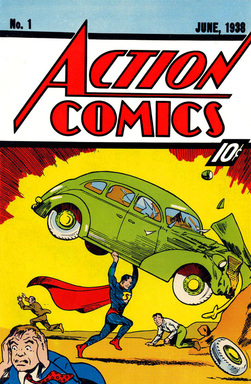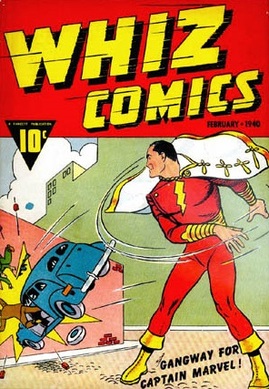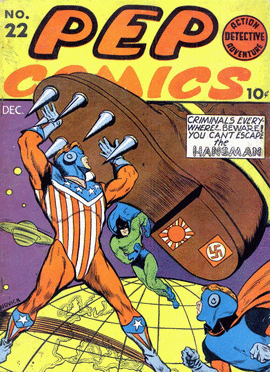THE GOLDEN AGE
c. 1938 - c. 1950
The Golden Age Of Comic Books describes an era of American comic books from the late 1930s to the early 1950s.
During this time, modern comic books were first published and rapidly increased in popularity. The superhero archetype was created and many well-known characters were introduced, including Superman, Batman, Captain America, Wonder Woman, and Captain Marvel.
An event cited by many as marking the beginning of the Golden Age was the 1938 debut of Superman in Action Comics #1. Its publisher was originally known as Detective Comics, Inc., and later as National Comics and as National Periodical Publications, before taking on the name of DC Comics. Superman's popularity helped make comics a major arm of publishing, which lead rival companies to create superheroes of their own to emulate Superman's success.
This period saw the arrival of the comic book as a mainstream art form, and the defining of the medium's artistic vocabulary and creative conventions by its first generation of writers, artists, and editors.
Between 1939 and 1941, Detective Comics Inc. and its sister company, All-American Publications, introduced popular superheroes such as Batman and Robin, Wonder Woman, the Flash, Green Lantern, the Atom, Hawkman, Green Arrow, and Aquaman.
Timely Comics, the 1940s predecessor of Marvel Comics, had million-selling titles featuring the Human Torch, the Sub-Mariner, and Captain America.
Patriotic heroes donning red, white, and blue were particularly popular during the time of the second World War. Many heroes of this time period battled the Axis powers, with covers such as Captain America Comics #1 (March 1941) showing the title character punching Nazi leader Adolf Hitler.
During this time, modern comic books were first published and rapidly increased in popularity. The superhero archetype was created and many well-known characters were introduced, including Superman, Batman, Captain America, Wonder Woman, and Captain Marvel.
An event cited by many as marking the beginning of the Golden Age was the 1938 debut of Superman in Action Comics #1. Its publisher was originally known as Detective Comics, Inc., and later as National Comics and as National Periodical Publications, before taking on the name of DC Comics. Superman's popularity helped make comics a major arm of publishing, which lead rival companies to create superheroes of their own to emulate Superman's success.
This period saw the arrival of the comic book as a mainstream art form, and the defining of the medium's artistic vocabulary and creative conventions by its first generation of writers, artists, and editors.
Between 1939 and 1941, Detective Comics Inc. and its sister company, All-American Publications, introduced popular superheroes such as Batman and Robin, Wonder Woman, the Flash, Green Lantern, the Atom, Hawkman, Green Arrow, and Aquaman.
Timely Comics, the 1940s predecessor of Marvel Comics, had million-selling titles featuring the Human Torch, the Sub-Mariner, and Captain America.
Patriotic heroes donning red, white, and blue were particularly popular during the time of the second World War. Many heroes of this time period battled the Axis powers, with covers such as Captain America Comics #1 (March 1941) showing the title character punching Nazi leader Adolf Hitler.
Although DC and Timely characters are well-remembered today, circulation figures suggest that the best-selling superhero title of the era was Fawcett Comics' title Captain Marvel, with sales of about 1.4 million copies per issue. The comic was published biweekly at one point to capitalize on its popularity.
As comic books grew in popularity, publishers began launching titles that expanded into a variety of genres. Dell Comics' non-superhero characters (particularly the licensed Walt Disney animated-character comics) outsold the superhero comics. The publisher featured licensed movie and literary characters such as Mickey Mouse, Donald Duck, Roy Rogers, and Tarzan. It was during this era that noted Donald Duck writer-artist Carl Barks rose to prominence.
Additionally, MLJ Magazines' introduction of Archie Andrews in Pep Comics #22 (December 1941) gave rise to teen humor comics, with the Archie Andrews character remaining in print well into the 21st century.
Additionally, MLJ Magazines' introduction of Archie Andrews in Pep Comics #22 (December 1941) gave rise to teen humor comics, with the Archie Andrews character remaining in print well into the 21st century.
During the late 1940s, the popularity of superhero comics waned. To retain reader interest, comic publishers diversified into genres such as war, Westerns, science fiction, romance, crime, and horror. Many superhero titles were cancelled or converted to other genres.




